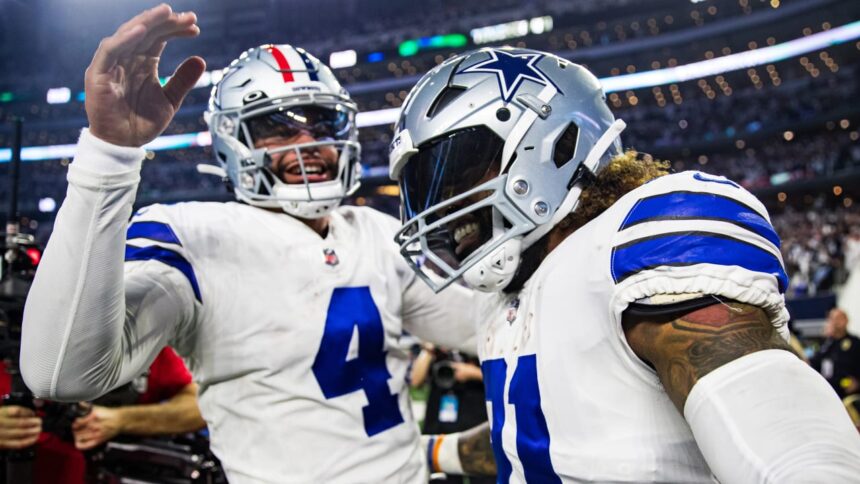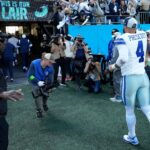FRISCO, Texas – Applause.
The Cowboys finally did what they should have done at the end of training camp last year.
Aiming to ink Ezekiel Elliott to a one-year deal for a $3 million max, just $2 million of that guaranteed.
And for goodness sakes, let’s not look at this as if some course correction for failing to draft a running back during the NFL Draft this past week. As if this is exactly why the Cowboys did not spend one of their eight draft choices on a running back, that they had Zeke in their back pocket.
Not so. After listening to the Cowboys address the issue on Thursday, Friday and Saturday, the Cowboys were going to do this all along after word of their Wednesday get-together broke out. All you had to do was pay close attention to Cowboys owner Jerry Jones during and after the day two press conferences when asked about Zeke.
First, during the press conference:
Does Zeke in your mind still have RB 1 starter capability at this point in his career?
“Yes … yes,” was Jerry’s succinct response.
Then, during a walk-off session just a few minutes after the presser, Jerry doubled down, saying about Zeke, “He’s good enough to be a running back for us and play for the Cowboys,” and then also pointing out, “He’s good enough to be a starter.”
Making it certain the Cowboys and Zeke would be back together after apart, Elliott having originally been released for cap-saving purposes.
And now, since signing a veteran does not impact the compensatory formula for next year based on unrestricted free agents lost and signed (See the signing of linebacker Damien Wilson too), Zeke should be back in the building once the ink is dry following a physical and the NFL putting him on the transaction wire.
This is a good thing. The Cowboys needed him last year to play caddie for Tony Pollard, and they once again need him this year, too. Think about the problems they incurred without a hard-nosed, no-nonsense running back for short yardage and goal-line duty. Think about all those times they struggled to punch the ball in for touchdowns when inside the 5-yard line or so. Nine times the Cowboys settled for field goals of no more than 28 yards – meaning the 10-yard line with four of those snapped from no more than the 5.
And still stuck in my mind the first possession in the 22-20 loss at Miami when on second-and-goal from the 2, Pollard tried to break a run outside, hitting hard off tackle for a touchdown, gaining just 1 yard. And then on the very next play, Dak Prescott and rookie Hunter Luepke botched the handoff, the Dolphins recovering at the 2. No points. Not even a perfunctory three.
Now sure, fully understand why the Cowboys didn’t want to keep Zeke for his $10.9 million base in 2023, especially after franchising Pollard for $10 million, making him a June 1 release. But even so, by doing that Zeke counted $5.8 million in dead money already paid him in guarantees last year and still is counting another $6.04 million this year, anyway. Might as well get something out of him for that.
Plus, last year was not as if the Patriots paid him a bundle. Just $3 million, with a $600,000 signing bonus. Would have been a welcome back do-over if he would have agreed to that with Dallas.
And look, not saying he needs to be the starter. Free agency hasn’t ended, right? And the trade deadline, by the way, is not until Nov. 5. But if you look at the room as is right now with Rico Dowdle, Royce Freeman, Luepke, Deuce Vaughn, Malik Davis, Snoop Connor and undrafted rookie Nathaniel Peete, those guys have totaled all of nine starts in the NFL, all belonging to the free-agent signee Freeman, yet eight of those during his 2018 rookie year in Denver.
That naturally provokes the question, then why didn’t the Cowboys draft a running back? Good question.
Here comes the good answer.
Nary a running back was drafted in the first round. The first back taken came in the second, Carolina selecting Jonathon Brooks of Texas with the 46th pick, 10 picks before the Cowboys selection at 56. Not worth trading up and costing themselves a third-rounder for a guy still recovering from ACL surgery.
The next running back wasn’t taken until the second pick in the third, Florida State’s Trey Benson going to Arizona. Benson did catch the Cowboys’ eye, but getting Marshawn Kneeland in the second was more important to their efforts to stop the run than to run the ball. And again, they weren’t going to trade precious picks to move up that far. Plus, to me, maybe the best pick of the eight the Cowboys made was Cooper Beebe – ninth in the third, 73rd overall – a guard moving to center, a position vital to running the ball better.
After that, the Rams grabbed Michigan’s Blake Corum at 83, the Cowboys selected linebacker Marist Liufau at 87, thinking he will be more vital than USC running back MarShawn Lloyd at 88, and the Cowboys did not have another pick until the 39th pick in the fifth round (174). By then, between Lloyd at 88 and the Cowboys selecting cornerback Caelen Carson in the fifth, 12 running backs went off the board.
My guess is by then, and likely through those 12 coming off the board, the Cowboys figured none were as good as or measurably better than Dowdle, when given the opportunity he should receive this year. And none giving them what Zeke can, between short-yardage power, ability to provide pass protection and some well needed locker room leadership.
There is more to running backs than yards per carry, the stat those anally into numbers want to cite for Zeke’s downfall. Sometimes you’ve just got to watch with your eyes. Zeke, to me, in 2022 was more than the 3.8 average per carry than most wanted to dismiss him with.
So here is a number that might have been overlooked when peeking inside the statistical box instead of just tying a ribbon and bow on it. While playing 11 of the first 13 games in 202, Zeke was averaging 4.3 yards a carry, and that without Tyron Smith at left tackle the entire season and with Terence Steele at right tackle for those 13 games. In six of those games, he averaged at least 4.1 a carry, with 5.2 in the opener against Tampa Bay, 4.9 and 5.8 in both games against the Giants and 6.2 against the Eagles.
But after Steele went down in Week 14 with a torn ACL against Houston and then Tyron Smith started the next four games at right tackle for the first time since 2012, Zeke’s averages fell to 3.6, 3.4, 1.9 and 1.3 in the final four, for a combined 2.7, a significant contribution to Zeke falling from that 4.3 to the 3.8 at the finish.
And in 2023, playing initially a backup role with New England and then starting five of the 17 games he played later in the season, Zeke only played 51 percent of the snaps while with the mostly pathetic 4-13 Patriots, ranked 30th offensively. Still, in his eighth season, Zeke led the Patriots in rushing (642 yards) and in receptions (51 catches for 313 yards), which means he produced a team-high 955 yards from scrimmage and finished second on New England with five total touchdowns, one behind tight end Hunter Henry’s six receiving touchdowns, though having played 75 percent of the snaps.
So all this despite quarterbacks Mack Jones and Bailey Zappe averaging 6.1 yards per pass attempt and posting a woeful team QB rating of 73.8, which is why Bill Belichick no longer is the head coach.
Who would you rather have at running back, like 173rd pick Isaiah Davis of South Dakota State in the fifth or Caelen Carson with the next pick and Zeke? Because chances are, by then and maybe even after the third round, and without a fourth, any running back drafted from the fifth round on likely would not have made this team, with or without Zeke.
So let’s not get bent out of shape because the Cowboys did not draft a running back within their top four picks. And none of this has anything to do with devaluing the running back. It’s the circumstances, both the way the draft fell for sure, and then in free agency the lack of cap affordability.
As for Zeke, heck yeah, welcome back.










